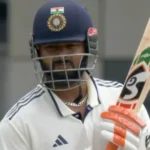Penalty Shootout Thriller: Hong Kong vs India in AFC Asian Cup Qualifiers
The smell of instant noodles and anticipation hung heavy in the air. Seriously, Kai Tak Stadium in Hong Kong isn’t exactly known for gourmet dining, but let me tell you, that smell – combined with the electric buzz of a packed crowd – is *the* scent of Asian football qualifying. I’ve been lucky enough to work as a match analyst for several AFC competitions over the last decade, everything from youth tournaments to the main event, and I’ve seen a lot of games. But this one, Hong Kong versus India in the AFC Asian Cup Qualifiers, had a different feel. It wasn’t just a game; it was a pressure cooker. And trust me, I could feel the heat even from the commentary box.
I’ve spent years breaking down matches, not just watching them, and my background isn’t just about knowing formations and player stats. I’ve coached at the amateur level, spent time with sports psychologists learning about the mental game, and got my start by literally charting player movements during local league matches. It’s this combination – the tactical eye, the understanding of the psychological battle, and the “boots on the ground” experience – that lets me see things others might miss. And this match? It had layers. Lots of them.
Let’s rewind a bit. The AFC Asian Cup is a huge deal in Asia. It’s the continental championship, the equivalent of the Euros or the Copa America. Qualifying isn’t easy. It’s a long, winding road with a lot of tricky opponents. Hong Kong, while historically a decent team, is often the underdog. India, on the other hand, has been steadily improving, boasting a growing pool of talented players and a passionate fanbase. The fact that this qualifier was being played at Kai Tak, a stadium with a relatively small capacity but a *massive* atmosphere thanks to its close proximity to the pitch, added to the intensity. I’d spent days beforehand analyzing both teams, going over their recent performances, identifying key players, and trying to predict their strategies.
India, under Igor Stimac, had been leaning into a fairly pragmatic approach: solid defensively, looking to hit teams on the counter. They weren’t flashy, but they were efficient. Hong Kong, led by Jorn Andersen, were trying to build a more possession-based game, aiming to control the midfield and create chances through intricate passing. On paper, it looked like a classic clash of styles.
Walking into the stadium on match day, the energy was palpable. The Hong Kong fans were in full voice, a sea of red and white, and the Indian supporters, while fewer in number, were making themselves heard with drums and chants. It was a proper football atmosphere, something you don’t always find in qualifying matches. You could tell both teams knew what was at stake. A win here wouldn’t just guarantee progression to the next stage of qualifying; it would be a massive boost to morale and a statement of intent.
From the first whistle, it was clear that both teams were feeling the pressure. The opening 15 minutes were scrappy, with a lot of misplaced passes and nervous tackles. Hong Kong were trying to stick to their possession game, but India were pressing them high up the pitch, disrupting their rhythm. I noted early on that India’s Sunil Chhetri, their captain and all-time leading goalscorer, was being effectively marked by Hong Kong’s center-backs. He wasn’t getting the space he needed to operate, and India were struggling to create clear chances as a result. This was a deliberate tactic by Andersen, and it was working. Chhetri is a wily veteran, incredibly intelligent in his movement, and shutting him down was a huge win for Hong Kong.
However, Hong Kong’s possession wasn’t translating into goal-scoring opportunities. While they dominated the ball, they lacked a creative spark in the final third. Stefan Pereira, the young winger everyone was talking about, was trying to make things happen, but he was finding it difficult to break down India’s well-organized defense. He’s a player with tremendous potential – raw pace, good dribbling skills – but he can sometimes be a bit predictable. He needs to add more variety to his game, learn when to take on a defender and when to play a simple pass. I’ve seen this with a lot of young, talented players; the key is to develop that footballing intelligence.
The first half ended goalless, a bit of a reflection of the tense, cagey nature of the game. At halftime, I spent time reviewing my notes with the broadcast team. We discussed India’s defensive shape, highlighting the importance of their holding midfielders, and Hong Kong’s struggles to penetrate the final third. We also spoke about the need for both teams to take more risks in the second half. Playing for a 0-0 draw wasn’t going to be enough for anyone.
The second half started with a bit more urgency. India came out with a renewed focus, trying to get the ball forward more quickly. They started to exploit the wings, using their pace to stretch Hong Kong’s defense. Hong Kong, meanwhile, were trying to find a way to unlock India’s backline. They started to play more direct, looking for opportunities to get the ball into the box.
Around the 65th minute, the game finally burst into life. A beautiful through ball from Hong Kong’s midfield found Pereira in space, and he raced towards goal. He cut inside, beat a defender, and unleashed a powerful shot that was brilliantly saved by India’s goalkeeper, Gurpreet Singh Sandhu. It was a stunning save, a testament to Sandhu’s reflexes and positioning. He’s been a cornerstone of the Indian team for years, and moments like that are why. From my vantage point, I could see he’d anticipated Pereira’s shot, getting a strong hand to it.
Just when it looked like Hong Kong was going to take the lead, India launched a devastating counter-attack. Chhetri, despite being well-marked for most of the game, managed to find a sliver of space, and he played a perfectly weighted pass to Brandon Fernandes. Fernandes, with time and space, unleashed a curling shot that flew into the back of the net. 1-0 to India.
The stadium went silent. The Hong Kong fans were stunned. You could feel the momentum shift completely. India were now in control, defending deep and looking to see out the game. Andersen made some changes, bringing on fresh legs and trying to inject some creativity into his team. But India were resolute, defending with everything they had.
But Hong Kong weren’t going to give up without a fight. They threw everything at India in the final 15 minutes, creating a flurry of chances. In the 85th minute, they were awarded a penalty. A clumsy challenge in the box gave the referee no choice but to point to the spot.
The tension was unbearable. The entire stadium held its breath as Hong Kong’s captain stepped up to take the penalty. He struck the ball well, sending Sandhu the wrong way. 1-1. The stadium erupted. The noise was deafening.
The remaining minutes of regulation time were frantic. Both teams were going for the win, but neither could find a breakthrough. The game went into extra time.
Extra time was another grueling affair. Both teams were visibly tired, but they continued to battle, driven by the desire to qualify for the Asian Cup. Chances came and went, but neither team could find the winning goal. I was starting to think this game was destined for a penalty shootout.
And I was right.
Penalty shootouts are a terrible way to decide a football match. It’s a lottery, a test of nerves as much as skill. But they are a part of the game. As a match analyst, you can try to predict who might buckle under the pressure, who might thrive. But ultimately, it’s down to the individual.
India went first. Their first penalty taker slotted it home with confidence. Hong Kong equalized. The next few penalties were all converted. The tension was excruciating. Every kick felt like an eternity.
Then came the turning point. India’s fourth penalty taker stepped up, took a deep breath, and fired his shot straight at the goalkeeper, who made a brilliant save. Hong Kong had a chance to take the lead.
Their player, however, blasted his penalty over the bar. The stadium groaned.
Suddenly, the pressure was all on India. They needed to score their final penalty to stay in the shootout. Their final taker, a young midfielder, walked towards the spot, looking visibly nervous. He took a run-up and… scored.
Hong Kong’s final penalty taker had to score to keep the shootout alive. He shot… and Sandhu saved it! India had won.
The Indian players and coaching staff erupted in celebration. The Hong Kong players collapsed to the ground, devastated. It was a heartbreaking end for them, but a fantastic victory for India.
Watching from the commentary box, I couldn’t help but feel a mixture of emotions. I felt for Hong Kong, who had fought so hard and deserved at least a draw. But I also felt admiration for India, who had shown incredible resilience and determination. And, honestly, a little bit of relief that *I* didn’t have to take a penalty!
What struck me most about this game wasn’t just the drama of the penalty shootout, but the tactical battle that unfolded over 120 minutes. Andersen’s attempt to nullify Chhetri was a bold move that initially worked but ultimately didn’t prove enough. Stimac’s pragmatic approach, prioritizing defensive solidity and capitalizing on counter-attacking opportunities, ultimately paid off.
This match also highlighted the importance of goalkeepers. Sandhu was outstanding throughout the game, but his performance in the penalty shootout was the difference between victory and defeat. He was calm, composed, and made two crucial saves. He truly earned his Man of the Match award.
Looking back, this game was a prime example of what makes Asian football so captivating: passion, intensity, and a willingness to fight for every single ball. It wasn’t a technically perfect game by any means. There were mistakes, missed opportunities, and moments of frustration. But it was a game filled with drama, excitement, and emotion. A game that reminded me why I love this sport.
Beyond the specifics of this match, I’ve seen a broader shift in Asian football over the past decade. There’s more investment in youth development, more players playing professionally in Europe and other top leagues, and a growing emphasis on tactical sophistication. Countries like Japan and South Korea have consistently been at the forefront of this, but others, like India, are starting to catch up.
I’ve had the opportunity to work with youth academies in several Asian countries, and the progress is remarkable. There’s a genuine commitment to nurturing talent and building sustainable footballing cultures. It’s not just about finding the next superstar; it’s about creating a system that produces a steady stream of capable players.
This also translates into coaching methodologies. I’ve observed a move away from purely physical training towards more holistic approaches that emphasize technical skill, tactical awareness, and mental toughness. Sports psychology is becoming increasingly integrated into player development programs, recognizing the importance of mindset and resilience.
However, challenges remain. Infrastructure is still lacking in many countries. Funding is often limited. And there’s a need to address issues like corruption and lack of transparency. But despite these obstacles, the future of Asian football looks bright.
The Hong Kong-India match at Kai Tak Stadium was just one small piece of that larger story. But it was a reminder of the passion, the drama, and the potential that exists within Asian football. And, yeah, maybe a reminder to always pack some instant noodles when heading to a match in Hong Kong. You never know when you’ll be stuck in a penalty shootout! It’s these little things, the details, the atmosphere, that make covering this game so rewarding. It’s about more than just X’s and O’s; it’s about the stories, the cultures, and the people who make Asian football so special. And as long as I have a seat with a view and a notepad in hand, I’ll be there to analyze it all. Because for me, the game is always worth watching, and always worth dissecting.
Anurag Dhole is a seasoned journalist and content writer with a passion for delivering timely, accurate, and engaging stories. With over 8 years of experience in digital media, she covers a wide range of topics—from breaking news and politics to business insights and cultural trends. Jane's writing style blends clarity with depth, aiming to inform and inspire readers in a fast-paced media landscape. When she’s not chasing stories, she’s likely reading investigative features or exploring local cafés for her next writing spot.






